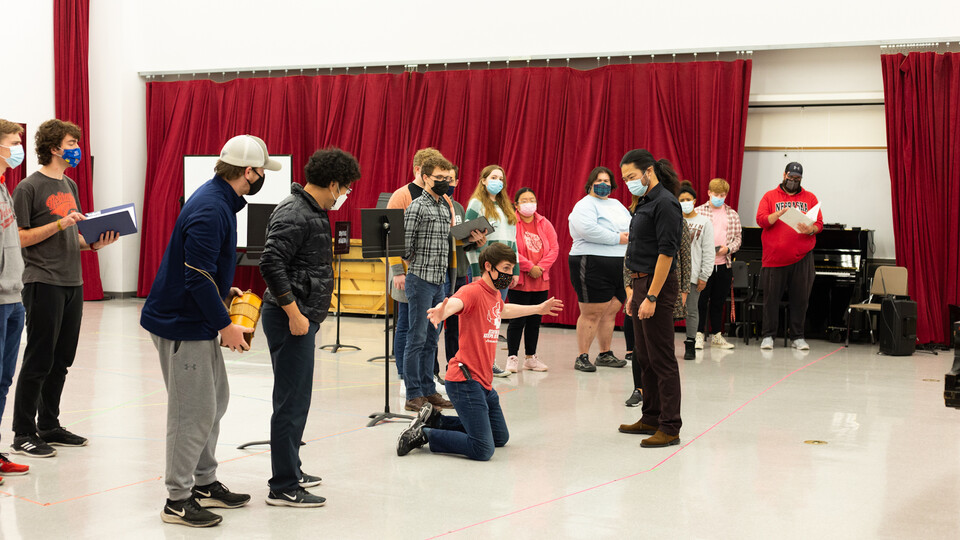· 5 min read
Opera to stage Mozart’s ‘The Magic Flute’

The Glenn Korff School of Music’s opera program will present Mozart’s “The Magic Flute” Nov. 5 and 7.
Performances are at 7:30 p.m. Nov. 5, and 3 p.m. Nov. 7 in Kimball Recital Hall. Tickets are $20 for adults and $10 for students/seniors and are available at the door or in advance through the Lied Center Box Office at 402-472-4747.
The Nov. 7 performance will also be live webcast.
Pre-performance talks by Pamela Starr, professor emerita of music history, will take place 45 minutes before curtain in the lobby of Kimball Recital Hall.
Mozart’s miraculous blend of the human and the supernatural follows the adventures of Prince Tamino and the bird-catcher, Papageno, on their quest to rescue the Princess Pamina. Along the way, they must contend with the forces of Nature and Reason, in order to achieve Wisdom, Spiritual Enlightenment and Love.
“I love this opera because its music and story have the power to appeal to everyone from the most erudite scholars to little children. By working on so many levels, it enchants us all,” said director William Shomos, Richard H. Larson Distinguished Professor of Music and director of opera.
The opera will be sung in English with supertitles. The new English version was written by Shomos this past summer.
“It was so much fun to create, and I really enjoyed tackling the various challenges,” he said. “First, it’s all written with end-rhymes, and I insisted on maintaining that. I also tried to maintain a poetic language throughout with lots of assonance and alliteration. I was disciplined in keeping any changes in Mozart’s vocal line to an absolute minimum. Then, I would always try to be cognizant of what vowels worked best for the singers—all the while trying to stay true to the original, but from my own angle and point of view.”
Krista Lawrence Sorensen, a graduate student, is portraying the Queen of the Night.
“The Queen of the Night is a powerful, headstrong woman whose daughter has been taken by Sarastro, ruler of the land of Light. As her name implies, she is the ruler of the land of Night,” Sorensen said. “She is also the one who sends Tamino on his quest to rescue Pamina. But not all is as it appears. She is also not afraid to chastise her daughter if she is disobedient.”
It’s an iconic role in opera.
“This role is, of course, one that is well-known, even among those with little knowledge of opera,” Sorensen said. “The main reason it’s so popular is because of the difficulty of her music. The Queen is willing to do anything to achieve her goals, and her second aria is one of the hardest songs for an operatic soprano. I am excited and grateful for the opportunity to take on this challenging role, and have been working very hard on my high notes in order to do her justice! The music was daunting at first, but it’s Mozart, so it’s very tuneful and a ton of fun to perform. Her character has a lot of depth, and I’m looking forward to portraying her.”
Shomos said Sorensen is up to the challenge.
“The Queen of the Night calls for a soprano with access to the extreme top of the voice. Krista Lawrence Sorensen is owning the role,” he said. “The Queen is all about the maternal, creative, irrational ‘feminine’ aspects of our being, which is utterly at odds with the paternal, rational, discipline-driven ‘masculine’ side of who we are, as represented by Sarastro, whose vocal range is at the bottom of the bass voice.”
The opera features guest artist Hidenori Inoue as Sarastro. He is the Ariel Bybee Endowed Visiting Professor of Opera. Inoue, bass baritone, hails from Himeji, Japan. In 2018-2019, he performed the roles of Leporello and Commendatore in “Don Giovanni” with Opera Steamboat, and the Bonze in “Madama Butterfly” with Virginia Opera and Opera Omaha.
“Sarastro requires a low and powerful bass voice, which is rarely found in any university setting,” Shomos said. “The entire cast is doing a beautiful job.”
Shomos said the opera has it all.
“It’s a fantastic group of wonderful, young performing artists,” Shomos said. “The score is in the orchestra’s wheelhouse; the cast inhabits the characters with commitment and energy and beautiful voices; the designers have created a look for the show that is imaginative, fun and true to the story.”
“The Magic Flute” features scenic and costume design by J.D. Madsen and Jamie Bullins, faculty with the Johnny Carson School of Theatre and Film. Music Director Tyler Goodrich White conducts the cast and orchestra. Carson School graduate student Abbey Smith is the lighting designer.
Sorensen said she is looking forward to performing in front of the audience again.
“Performing in front of an audience in person again is like a dream come true,” she said. “It’s not until you’ve sung for an empty room for over a year and half that you realize just how much the performers need their listeners. It’s truly a symbiotic relationship, and we are thrilled to give back by putting on the best show we can for them.”







